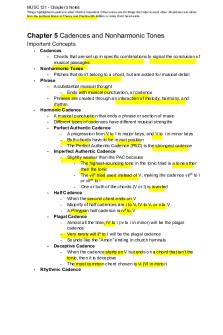3 - Summary marketing theory and practice PDF

| Title | 3 - Summary marketing theory and practice |
|---|---|
| Author | Shunyu Yao |
| Course | marketing theory and practice |
| Institution | Monash University |
| Pages | 3 |
| File Size | 60.4 KB |
| File Type | |
| Total Downloads | 50 |
| Total Views | 163 |
Summary
chapter 3...
Description
Collecting Information and Forecasting Marketing Demand 1. What are the 3 components of a marketing information system (MIS)? (p.89)
MIS consists of people, equipment, and procedures to gather, analyze, evaluate, and distribute needed, timely, and accurate information to marketing decision makers.
The MIS helps managers to assess information needs, develop needed information & distribute in a timely manner.
a) Internal Records: supplies results data. marketing managers rely on internal reports of orders, sales, prices, costs, inventory levels, receivables, and payables. Eg. order to payment cycle and sales information system (timely and accurate current sales). b) Marketing intelligence(市场情报): supplies happenings data. A set of procedure to obtain everyday information about marketing environment through (reading newspapers; talking to customers, suppliers, distributors, and other company managers; and monitoring online social media).
8 actions to improve quality and quantity of marketing intelligence. i.
Motivate sales force to report new developments
ii.
Motivate intermediaries to pass along intelligence
iii.
Hire external experts to collect intelligence
iv.
Network internally and externally
v.
Set up a customer advisory panel
vi.
Take advantage of government-related data
vii.
Purchase information from outside research vendors
viii.
Collect marketing intelligence on Internet: find competitors strengths and weakness online.
c) Marketing research: systematic design, collection, analysis and
reporting relevant data relevant to a specific marketing situations. 2. 6 major forces in the broad environment. 1) Demographic:
Worldwide population growth
Population age mix
Ethnic composition 种族构成. Eg. Indian American
Educational levels. Eg. illiterates, school dropouts, diploma…
Household patterns (the rise of nontraditional families). Eg. wife, husband, children (traditional pattern). 2) Economic: marketers need to focus on consumer phycology, income distribution and levels of saving debt and credit availability. 3) Social culture: marketers must understand people’s views of themselves (pleasure seeker, self-realization, more conservative), others (concern social problems, seeking those who like themselves), organizations (win back consumer confidence), society, nature, and the universe. Their products must correspond to society’s core (fairly persistent Eg. marriage) and secondary values (open to change Eg. marry early) and address the needs of different subcultures (emerging from special life experience). 4) Natural: marketers are concern more about natural, embracing green and sustainably programs. 5) Technological: marketers should take account of the accelerating pace of technological change, opportunities for innovation, varying R&D budgets, and the increased governmental regulation (increased food safety regulations). 6) Political legal: marketers must work within the laws regulating business practices and with various special-interest groups (respect the rights of women, consumers, gays…).
3. Demand measure Useful for market planning
Potential market: sufficient interest, not enough to define unless they have sufficient income and access. Reposition itself in the minds of
customer
Available market: sufficient interest, income and access. Expand available market or lowing price.
Qualification available market: sufficient interest, income, access and qualification (Eg. only adult can buy motorcycle). Lower qualifications
Target market: part of QAM. E.g. concentrate market effort on east coast. Attract buyers
Penetrated market: consumers who are buying the product....
Similar Free PDFs

Banking theory and practice
- 2 Pages

Social WORK Theory AND Practice
- 40 Pages

Social WORK Theory AND Practice
- 42 Pages

Book-Leadership+Theory+and+Practice
- 505 Pages

Theory and Reality Book Summary
- 25 Pages

marketing practice
- 34 Pages

Experiential Marketing Theory
- 2 Pages
Popular Institutions
- Tinajero National High School - Annex
- Politeknik Caltex Riau
- Yokohama City University
- SGT University
- University of Al-Qadisiyah
- Divine Word College of Vigan
- Techniek College Rotterdam
- Universidade de Santiago
- Universiti Teknologi MARA Cawangan Johor Kampus Pasir Gudang
- Poltekkes Kemenkes Yogyakarta
- Baguio City National High School
- Colegio san marcos
- preparatoria uno
- Centro de Bachillerato Tecnológico Industrial y de Servicios No. 107
- Dalian Maritime University
- Quang Trung Secondary School
- Colegio Tecnológico en Informática
- Corporación Regional de Educación Superior
- Grupo CEDVA
- Dar Al Uloom University
- Centro de Estudios Preuniversitarios de la Universidad Nacional de Ingeniería
- 上智大学
- Aakash International School, Nuna Majara
- San Felipe Neri Catholic School
- Kang Chiao International School - New Taipei City
- Misamis Occidental National High School
- Institución Educativa Escuela Normal Juan Ladrilleros
- Kolehiyo ng Pantukan
- Batanes State College
- Instituto Continental
- Sekolah Menengah Kejuruan Kesehatan Kaltara (Tarakan)
- Colegio de La Inmaculada Concepcion - Cebu








